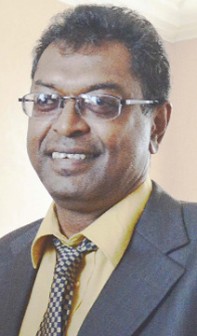The success of the government’s gun amnesty programme during a two-month trial period will determine whether it will be continued, according to Minister of Public Security Khemraj Ramjattan.
The programme is to begin on September 1st and it is being initiated against the backdrop of the police’s continued recovery of illegal guns. The country’s porous borders have for years made it difficult to curb gun running.
In a recent interview at the Public Buildings, Ramjattan said the amnesty would be conducted during September and October and if it is successful then the programme will be continued. “I am certain at the end of the two months we will know what it is, whether it is efficacious a policy, or if it is not but we should give it a try,” said Ramjattan, who seemed confident that the government is moving in the right direction.
At the moment, he noted, police stations where firearms can be turned in are being identified as well as the civilians who will accompany lawmen when collections are made. He explained that he has to make an order outlining these two things and this will then have to be gazetted to allow for the programme to become operational. He expected to complete the process during the course of this week.
The Government Infor-mation Agency (GINA) last weekend reported that the gun amnesty is one of several strategies being implemented to address crime. The report said too that the amnesty was raised and discussed during a high level security meeting that was convened in July in response to growing concerns about the crime rate. At that meeting, government was brought up to date on several measures that could be utilised to encourage persons to hand over illegal firearms to authorities.

The GINA report also noted that the initial feedback from the Guyana Police Force suggests that members of the public may not want to hand over illegal firearms to police ranks and therefore alternative methods to collect the firearms are being explored. “This may see a civic or an independent organisation being used to facilitate the process,” the report added.
Under the amnesty, Ramjattan previously told Stabroek News, once firearms are brought in they would be collected and no questions would be asked and no one would be charged.
For years, gun amnesties have been considered by Trinidad and Tobago as well as Jamaica, which have faced similar crime problems, but neither has followed through.
Asked why the programme was being considered even though President David Granger had in the past suggested that such a scheme could not work, Ramjattan said that for him it is a viable option to get the firearms off the street.
In 2007, Granger had said in an interview with Stabroek News that he was not in favour of a gun amnesty as he felt it would not work in Guyana. He argued then that there had to be two approaches to tackling gun smuggling. The first was strong intelligence – identifying the source of the weapons, who were the traffickers (gun-runners), the various networks, and how the weapons were being trafficked and distributed—and the second was enforcement of the laws.
Stopping the influx
A security official, who asked not to be named, said Guyana is faced with a situation where guns are flowing into the country with ease and that for an amnesty to achieve its intended objectives, efforts would have to be made to stop the flow.
“It has to be a combined effort of doing something to stop it from coming in… we need a series of steps to prevent the influx of these weapons,” the official said, while opining that the initiative may not be a bad idea given the amount of guns which have found their way into the country and which are being traded from hand to hand on a daily basis.
He said there is evidence to suggest that guns are coming from Venezuela, Brazil and Suriname into Guyana.
The official said guns are smuggled into the country from Venezuela in various items and off of the Venezuela/Guyana border there are numerous routes through small rivers and dense jungle that smugglers can use to avoid detection. Most of these areas are not manned by the joint services largely because of a lack of human resources and equipment.
The official said although in the past information had been passed on to authorities about the smuggling activities,
nothing was done and before long gun smuggling became a lucrative trade.
It was also noted that Brazil is a big producer of small arms and Guyana shares a porous border with that country.
“If you can buy liquor and chicken, why you can’t bring in guns?” the official said.
The official suggested that using drones to monitor the borders might be a good option to address the situation, particularly in light of the lack of sufficient ranks to adequately protect the border areas. He said too that they would be cost effective and pointed out that countries with less than half of Guyana’s geographical size are using drones. Drones are small aircraft which are remotely piloted by either persons on the ground or onboard computers.
The official stressed that there is no way the possession of illegal firearms can be effectively tackled without the authorities cutting off the supply or source of those weapons.
It was pointed out that countries such as Britain, Canada and the USA have successfully utilised gun amnesties in the past.
“None of these things will make sense if you don’t clamp down on where the guns are coming from. You got to find out too who are the people involved in the firearm trade,” the official said, while also noting that coming up with initiatives without careful assessments will not be effective.




